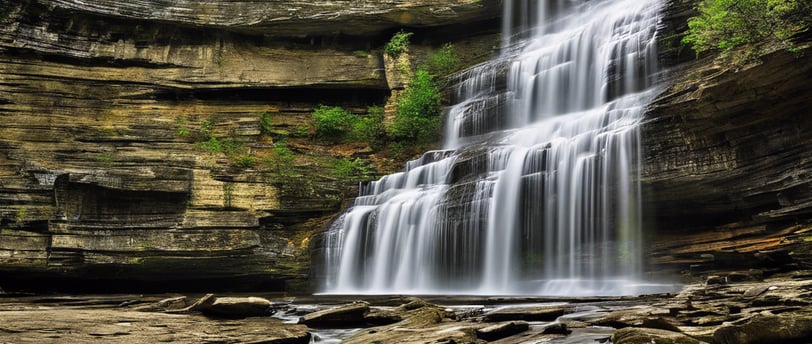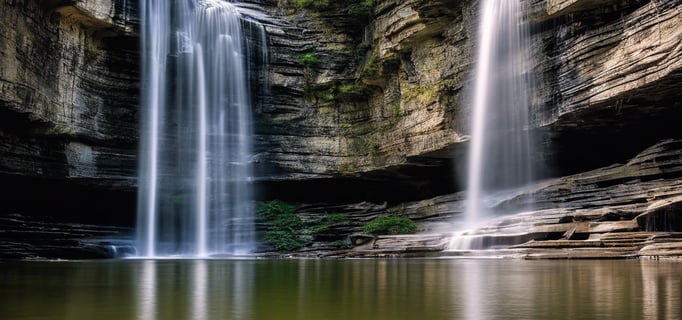"Explore 5 Stunning Waterfall Hikes in Tennessee"
Discover the beauty of Tennessee’s diverse landscapes with this guide to five breathtaking waterfall hikes. From the cascading Twin Falls at Rock Island State Park to the serene Greeter Falls in South Cumberland State Park, this post highlights trail details, waterfall heights, and tips for a safe and enjoyable adventure. Whether you're a seasoned hiker or a nature enthusiast, these waterfalls offer unforgettable experiences in the heart of the Volunteer State.
HIKING AND TRAVEL
Jennifer Miller
11/20/20245 min read


Discover 5 Stunning Waterfalls in Tennessee: A Guide to Trails, Parks, and Tips
Tennessee is home to over 500 waterfalls, a natural abundance resulting from the state’s unique geological features and diverse landscapes. The dramatic elevation changes, particularly in the eastern and central regions, create ideal conditions for waterfalls to form. The Cumberland Plateau, with its porous sandstone and limestone, plays a significant role in shaping these features. Over thousands of years, water has carved through the rock, creating steep cliffs and cascading falls. Tennessee’s extensive network of rivers, creeks, and springs also contributes to its wealth of waterfalls. Major waterways like the Tennessee, Cumberland, and Collins Rivers, along with their tributaries, often plunge over rocky ledges, forming breathtaking drops.
The temperate climate ensures consistent rainfall throughout the year, keeping waterfalls flowing even in drier seasons. Protected natural areas, such as Fall Creek Falls State Park, South Cumberland State Park, and Great Smoky Mountains National Park, preserve this beauty and make it accessible to visitors. The diverse elevation zones across Tennessee, from the Appalachian Mountains in the east to the Highland Rim and Cumberland Plateau in the central region, enhance the variety and scale of its waterfalls.
Tennessee’s landscape is strikingly different from the rugged charm of New England where I grew up. While New England is defined by rocky coastlines, rolling hills, and dense birch and maple forests, Tennessee offers a more dramatic and varied terrain. The Cumberland Plateau, with its towering cliffs and deep gorges, contrasts sharply with New England’s gentler topography. Here in Tennessee, waterfalls cascade over limestone and sandstone formations, often hidden within lush, subtropical-like forests, creating scenes that feel almost otherworldly compared to the granite cliffs and glacial lakes of the Northeast.
The sheer number of waterfalls in Tennessee is astonishing. New England has its fair share of beautiful cascades, but they’re often smaller and fewer in number due to its glacially carved valleys and steadier terrain. In contrast, Tennessee’s abrupt elevation changes create conditions for hundreds of waterfalls, each unique in height and character. Where New England’s waterfalls are framed by vibrant autumn foliage, Tennessee’s falls are surrounded by thick greenery, moss-covered rocks, and the subtropical biodiversity of the Southeast.
Exploring Tennessee’s natural wonders has been a refreshing and inspiring experience, offering a new appreciation for how geography and geology shape the beauty of the land. It’s a landscape that feels alive and dynamic, constantly reminding me how different, yet equally magnificent, this corner of the country is compared to where I started.
From cascading giants to hidden gems, Tennessee is a haven for nature lovers and waterfall enthusiasts. Let’s dive into five of its most remarkable waterfalls, complete with details on trails, elevation, and safety tips for a fun hiking experience.
1. Twin Falls
Park: Rock Island State Park
City: Rock Island, TN
Trail: Blue Hole Trail
Mileage: 0.6 miles (round-trip)
Elevation Gain: ~100 feet
Height of Falls: 80 feet
Water Body: Collins River
Description: Twin Falls is unique in that it’s created by water spilling from an underground cavern into the Collins River. It’s easily accessible via the Blue Hole Trail, which offers stunning views of the falls. The trail is short but can be slippery near the water’s edge.
Extend Your Hike: For a longer adventure, combine the Blue Hole Trail with the Eagle Trail:
Mileage: 3.0 miles (round-trip)
Elevation Gain: ~200 feet
Description: The Eagle Trail begins near the Twin Falls overlook and winds through wooded areas with stunning views of the Collins River. Together, the combined trails create a 3.6-mile hike.
Tips:
Wear sturdy, waterproof shoes for navigating wet areas.
Swimming is not allowed near the falls for safety reasons.
Plan extra time if adding the Eagle Trail to your hike.
2. Cummins Falls
Park: Cummins Falls State Park
City: Cookeville, TN
Trail: Gorge Access Trail
Mileage: 3 miles (round-trip)
Elevation Gain: ~200 feet
Height of Falls: 75 feet
Water Body: Blackburn Fork State Scenic River
Description: This majestic waterfall cascades into a popular swimming hole. The hike to the falls via the Gorge Access Trail involves creek crossings and uneven terrain, making it moderately challenging.
Tips:
Permit Required: A Gorge Access Permit is mandatory for safety and conservation.
Check water levels before visiting; the area can flood quickly during heavy rains.
Bring water shoes for creek crossings.
3. Burgess Falls
Park: Burgess Falls State Park
City: Sparta, TN
Trail: River Trail and Service Road Loop
Mileage: 1.5 miles (round-trip)
Elevation Gain: ~250 feet
Height of Falls: 130 feet
Water Body: Falling Water River
Description: Known for its dramatic plunge, Burgess Falls is the crown jewel of this park. The River Trail leads you past three smaller falls before reaching the grand finale.
Tips:
Stay on designated trails as the area near the falls can be dangerous.
Photography lovers: Visit early morning for the best lighting and fewer crowds.
4. Foster Falls
Park: South Cumberland State Park
City: Sequatchie, TN
Trail: Climbers Loop Trail
Mileage: 1.6 miles (round-trip)
Elevation Gain: ~350 feet
Height of Falls: 60 feet
Water Body: Fiery Gizzard Creek
Description: Foster Falls is a breathtaking cascade surrounded by rugged cliffs. The Climbers Loop Trail takes you to the base of the falls and offers excellent views.
Tips:
Bring a picnic! There’s a designated area near the trailhead.
The rocks around the base are slick—watch your footing.
5. Greeter Falls
Park: South Cumberland State Park
City: Altamont, TN
Trail: Greeter Falls Loop Trail
Mileage: 1.1 miles (round-trip)
Elevation Gain: ~150 feet
Height of Falls: 50 feet (Lower Falls)
Water Body: Firescald Creek
Description: Greeter Falls features two tiers—the upper and lower falls. A spiral staircase adds a touch of adventure to this short but rewarding hike.
Tips:
Wear shoes with good grip for navigating the rocky descent.
Check trail conditions beforehand; icy spots can form in colder months.
General Tips for a Safe and Fun Hike
Check the Weather: Tennessee’s waterfalls can swell rapidly after rainfall, making trails slippery and unsafe.
Wear Proper Gear: Waterproof hiking boots and weather-appropriate clothing are essential.
Stay Hydrated: Bring plenty of water, especially during warmer months.
Leave No Trace: Keep the trails and parks clean by packing out what you pack in.
Stay on Trails: Venturing off-trail can be dangerous and disrupt the ecosystem.
Bring a Map or GPS: Cell service may be spotty in some areas.
Plan Ahead: Some parks, like Cummins Falls, require permits or have specific safety guidelines.
From the thunderous roar of Burgess Falls to the serene beauty of Greeter Falls, Tennessee’s waterfalls offer unforgettable experiences. Lace up your boots, grab your camera, and immerse yourself in the natural splendor of these stunning cascades!

